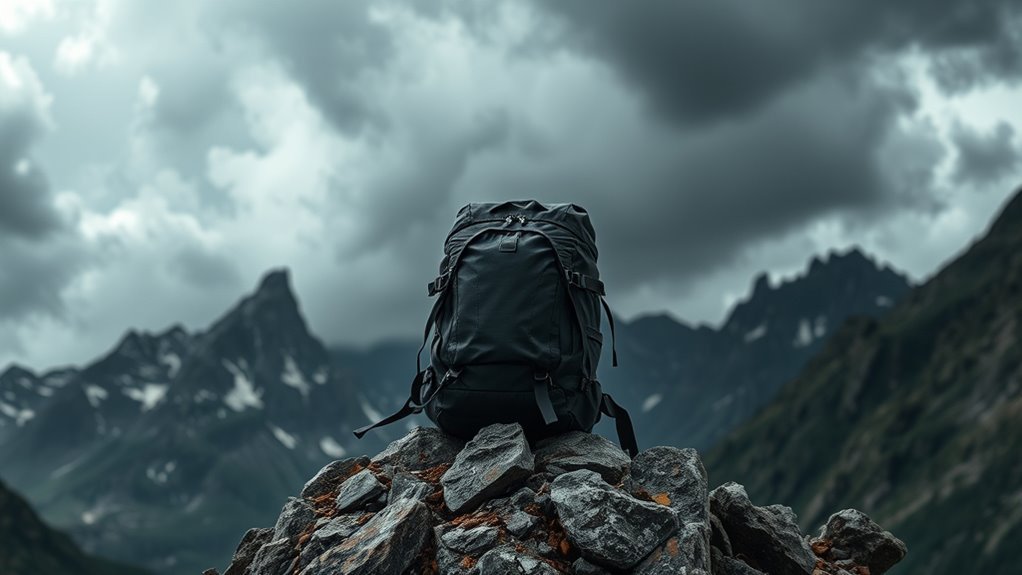Staying safe in a vehicle or outdoors during squalls requires vigilance and preparation. Check tires, wipers, and lights before driving, and maintain a safe distance from other vehicles. If caught outside, seek shelter and monitor the weather. It's essential to keep emergency supplies handy, such as food, water, and a flashlight. After the squall, remain cautious of debris and flooding. To further improve safety measures, including more detailed tips and techniques could be beneficial.
Main Points
- Reduce speed and maintain a greater following distance to adapt to decreased visibility and traction during squalls.
- Ensure your vehicle is prepared with proper tire conditions, fully functioning lights, and a stocked emergency kit.
- If caught outdoors, seek immediate shelter and stay low to protect against strong winds and flying debris.
- Monitor weather updates regularly to stay informed about changing conditions and potential dangers.
- Post-squall, remain cautious of debris, compromised road conditions, and avoid areas prone to flooding.
Understanding Squalls and Their Dangers
Although squalls can occur suddenly, their dangers are often underestimated. These intense weather phenomena can bring rapid changes in wind and precipitation, typically marked by short bursts of heavy rain or snow.
Squalls can lead to severely reduced visibility, causing hazardous driving conditions and increasing the risk of accidents. Additionally, the strong winds associated with squalls can uproot trees, down power lines, and create flying debris that poses threats to both vehicles and pedestrians.
Furthermore, the unpredictable nature of squalls can catch individuals off guard, especially those engaging in outdoor activities. As temperatures drop during a squall, there is also a risk of hypothermia for those exposed to the elements.
Understanding the potential severity of squalls is essential for everyone, as awareness can greatly improve safety measures and response strategies during these unpredictable weather events.
Preparing Your Vehicle for Squall Conditions

When preparing for squall conditions, individuals should prioritize their vehicle's readiness to guarantee safety and stability on the road.
First, checking tire conditions is essential; tires should have adequate tread depth and proper inflation to improve grip on slick surfaces.
Next, confirming that windshield wipers are in good condition and that the washer fluid is full can greatly enhance visibility during heavy rain.
Additionally, individuals should inspect their vehicle's lights, including headlights and brake lights, to verify they function properly, as visibility may be severely compromised.
It is also prudent to keep an emergency kit in the vehicle, stocked with essentials such as water, non-perishable food, a flashlight, and a first aid kit.
Finally, verifying that the fuel tank is full can prevent potential issues if travel becomes necessary during a squall.
Preparedness is key to maneuvering these unpredictable weather events safely.
Safe Driving Techniques During Squalls
Driving during squalls requires heightened awareness and specific techniques to guarantee safety. Drivers should reduce their speed considerably, as visibility and traction can decrease rapidly in adverse weather conditions.
Maintaining a greater following distance is essential, allowing more time to react to sudden stops or hazards. Utilizing headlights is vital, as it improves visibility for both the driver and other vehicles on the road.
Drivers should also avoid sudden maneuvers, as they can lead to loss of control on slick surfaces. Instead, gentle steering and gradual braking are recommended.
If conditions worsen, pulling over to a safe area and waiting for the squall to pass may be the best option. Finally, staying informed through weather updates and alerts can help drivers make timely decisions about their travel plans.
What to Do if You're Caught Outdoors

When caught outdoors during a squall, individuals should prioritize seeking immediate shelter to protect themselves from the elements.
Staying low and securing oneself in a safe location can help mitigate risks from high winds and flying debris.
Additionally, monitoring weather updates is essential to stay informed about changing conditions and potential dangers.
Seek Shelter Immediately
Sudden squalls can pose serious threats to those caught outdoors, making immediate shelter a top priority. When a squall strikes, individuals should quickly assess their surroundings for safe shelter options.
Natural cover, such as dense trees or a sturdy rock formation, can provide temporary relief from harsh winds and rain. If possible, seeking man-made structures, such as buildings or vehicles, is advisable.
Avoid shelters that could be hazardous, such as under tall trees that may shed branches. As wind speeds increase, staying away from open areas becomes essential to avoid being exposed to flying debris.
Remaining vigilant and making swift decisions can greatly reduce the risks associated with these sudden weather events, ensuring one's safety until conditions improve.
Stay Low and Secure
After seeking shelter from the initial impact of a squall, individuals caught outdoors should focus on staying low and securing themselves against the elements.
This involves finding a low-lying area, such as a ditch, to minimize exposure to strong winds and falling debris. Staying close to the ground helps reduce the risk of injury from gusts and projectiles.
It is vital to shield the head and neck with hands or an available item, such as a backpack, to protect against possible impacts. Additionally, individuals should avoid standing under trees or near structures that may collapse.
Remaining calm and patient until the squall passes is essential for personal safety, as moving during intense conditions increases vulnerability to hazards.
Monitor Weather Updates
Although squalls can develop rapidly, staying informed about weather updates is essential for anyone caught outdoors. Individuals should utilize available technology, such as smartphones and weather apps, to receive real-time alerts from trusted sources.
NOAA Weather Radio is another crucial tool, providing continuous broadcasts of weather information. When possible, it is advisable to seek shelter in a sturdy building or vehicle while monitoring conditions.
Keeping a portable battery charger for gadgets guarantees continued access to critical updates. If caught in a remote area, consider carrying a portable weather radio to stay informed.
Emergency Supplies to Keep Handy

Preparation is essential when it comes to maneuvering the unpredictable nature of squalls. Having emergency supplies readily available can greatly improve safety during these sudden weather events.
A well-equipped vehicle or outdoor kit should include items such as a first aid kit, non-perishable food, and bottled water, ensuring basic needs are met. Additionally, a flashlight with extra batteries is vital for visibility during power outages or poor weather conditions. A portable phone charger or power bank can be indispensable for maintaining communication.
Warm clothing, including blankets or sleeping bags, offers protection against sudden drops in temperature. A whistle or signaling instrument can assist in alerting rescuers if help is needed.
Finally, a multi-tool can prove versatile for various emergencies. By keeping these supplies organized and accessible, individuals can better safeguard themselves against the unpredictable challenges posed by squalls.
Recognizing Signs of an Approaching Squall
Recognizing the signs of an approaching squall is essential for safety. Observers may notice darkening skies and rapidly forming clouds, which often signal the imminent arrival of severe weather.
Additionally, a sudden drop in temperature and increased wind gusts can further indicate that a squall is on its way.
Darkening Skies and Clouds
As dark clouds begin to gather overhead, the atmosphere can shift dramatically, signaling the approach of a squall. Observers should pay close attention to the color and movement of the clouds; ominous, dark gray or black clouds often indicate severe weather conditions.
Rapidly swirling clouds may suggest an intensifying storm, while flat, low-hanging clouds can signify a squall's imminent arrival. The presence of towering cumulonimbus clouds is particularly telling, as they are associated with heavy rainfall and strong winds.
Additionally, an increase in wind speed and gusts can accompany the darkening skies, further hinting at the approaching squall. Recognizing these visual cues can be essential for ensuring safety when outdoors or traveling in a vehicle.
Sudden Temperature Drop
When a sudden drop in temperature occurs, it often serves as a crucial indicator of an approaching squall. This abrupt change can be felt within minutes and is typically accompanied by a shift in atmospheric pressure.
Observers may find that the air feels noticeably cooler, often leading to discomfort, and animals may exhibit unusual behavior, seeking shelter or becoming restless. Additionally, moisture in the air can intensify, indicating the likelihood of precipitation.
It is essential for individuals to remain vigilant during this time, as a sudden temperature drop can precede severe weather conditions. Recognizing these signs early can help in making informed decisions, ensuring safety in outdoor settings or while driving.
Preparedness is key when facing unpredictable weather changes.
Increased Wind Gusts
Gusts of wind can suddenly intensify, signaling the imminent arrival of a squall. Observing these changes can help individuals take precautionary measures. Recognizing the signs of increased wind gusts is vital for safety.
Key indicators include:
- Rapid Wind Shifts: A noticeable change in wind direction and speed can precede a squall.
- Whistling Sounds: As wind speeds escalate, the sound may become a high-pitched whistle, indicating strong gusts.
- Debris Movement: Loose branches, leaves, and other debris being tossed about can signify the approaching storm.
Post-Squall Safety Tips and Considerations
Although the storm may have passed, the aftermath of a squall can still pose considerable risks. Individuals should remain cautious as debris, such as fallen branches or power lines, may obstruct roadways and pose hazards.
It is advisable to wait for official clearance before venturing out, as emergency services will be evaluating damage and ensuring safety.
Drivers should be particularly vigilant, as road conditions may be compromised. Flooding can occur suddenly, and even shallow waters can be deceptive.
In addition, after a squall, wind gusts can still be strong, increasing the danger of loose objects becoming projectiles.
For outdoor enthusiasts, it is essential to check weather updates and avoid areas prone to flash flooding.
Finally, individuals should be mindful of their surroundings, reporting any downed power lines or dangerous conditions to authorities to aid in the recovery efforts. Safety should always remain the top priority.
Common Questions
How Do Squalls Differ From Regular Storms?
Squalls are sudden, intense bursts of wind and precipitation, often occurring without warning, unlike regular storms that develop more gradually. They can lead to sudden changes in weather conditions, creating hazardous situations for those caught unprepared.
Can Squalls Occur in Any Season?
Squalls can occur in any season, as they are defined by sudden changes in weather conditions. Meteorologically, they can manifest due to various atmospheric factors, making them unpredictable and potentially hazardous regardless of the time of year.
What Are the Signs of a Severe Squall?
Signs of a severe squall include rapid temperature drops, sudden gusts of wind, darkening skies, increased cloud cover, heavy rain or hail, and reduced visibility. Observing these indicators can help individuals prepare for impending dangerous weather conditions.
Are Squalls More Common in Certain Regions?
Squalls are indeed more prevalent in specific regions, particularly coastal areas and the Great Plains. Their occurrence often correlates with atmospheric conditions, including temperature contrasts and moisture levels, making certain locales more susceptible to these sudden storms.
How Can I Receive Alerts for Approaching Squalls?
To receive alerts for approaching squalls, one can utilize weather apps, subscribe to local weather services, or enable notifications from national meteorological organizations. These methods guarantee timely updates regarding severe weather conditions and potential hazards.

